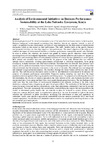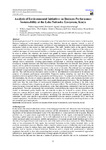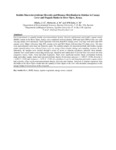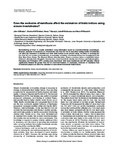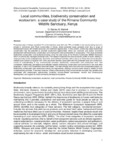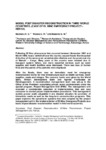Browsing School of Environment and Natural Resources by Subject "Kenya"
Now showing items 1-10 of 12
-
Analysis of Environmental Initiatives on Business Performance Sustainability at the Lake Naivasha Ecosystem, Kenya
(Journal of Environment and Earth Science, 2014)Increasing degradation of the natural environment is one of the main threats to human survival in the long term. Business enterprises’ environmental commitment has, therefore, become an important variable in most of today’s ... -
Analysis of Environmental Initiatives on Business Performance Sustainability at the Lake Naivasha Ecosystem, Kenya
(2014)Increasing degradation of the natural environment is one of the main threats to human survival in the long term. Business enterprises’ environmental commitment has, therefore, become an important variable in most of today’s ... -
Benthic Macro-invertebrate Diversity and Biomass Distribution in Relation to Canopy Cover and Organic Matter in River Njoro, Kenya
(Egerton University, 2013)Field experiments to quantify benthic macroinvertebrate density, diversity and biomass and benthic organic matter (BOM) content in the River Njoro, Kenya, were conducted between January 2009 and April 2009 at four sites ... -
Determinants for the purchase of woven products among consumers in Kisumu County, Kenya
(2019)This research was designed to establish the determinants for the purchase of woven products among consumers in Kisumu County, Kenya. By definition, woven products are products made by interlacing fibrous materials like ... -
Do Smallholder Farmers Perceive Rainfall Variability the Same and Correctly? Gendered and Spatial Analysis of Perception Versus Actual Trends of Rainfall in Three Livelihood Zones in Kenya
(Journal of Environment and Earth Science, 2018)In this paper we compared perceived rainfall variability with actual rainfall variability using a more nuanced and mixed approach in order to understand the influence of gender dynamics and spatial location on perceptions. ... -
Does the exclusion of meiofauna affect the estimation of biotic indices using stream invertebrates?
(Taylor & Francis, 2016)Biomonitoring of rivers is usually undertaken using information based on macroinvertebrate assemblages. However, exclusion of meiofauna (i.e. invertebrates less than 0.5 mm in size) when sorting benthic invertebrates can ... -
Effect of Sieve Mesh Size on the Estimation of Benthic Invertebrate Abundance and Composition in the Honi River, Kenya
(Nature Kenya/East African Natural History Society, 2014)Characterisation of benthic invertebrate communities, taxonomic abundance and composition provides information that is used during river bioassessment. However, the mesh size of the sieves used during processing of ... -
Invertebrate drift densities in the Njoro and Kamweti Rivers in the Kenyan highlands that differ in the level of anthropogenic disturbances
(Taylor & Francis, 2018)Invertebrate drift is one of several fundamental ecological processes in streams. However, little is known about the dynamics of invertebrate drift in Kenyan streams. In this study, we assessed invertebrate drift in two ... -
Local communities, biodiversity conservation and ecotourism: acase study of the Kimana Community Wildlife Sanctuary, Kenya
(2016)Protected areas in Kenya constitute 7% of the total land area with over 75% of wildlife in the country being found on private or communal land. Rural communities in Kenya, where protected areas generally exist, ... -
Model Post Disaster Reconstruction in Third World Countries, (Case of El Nino Emergency Project– Kenya)
(2007)Following El Nino phenomena that occurred between November 1997 and March 1998, heavy rainfall all over the country caused floods that impacted thirty-five of the seventy-six administrative districts and the provincial ...

